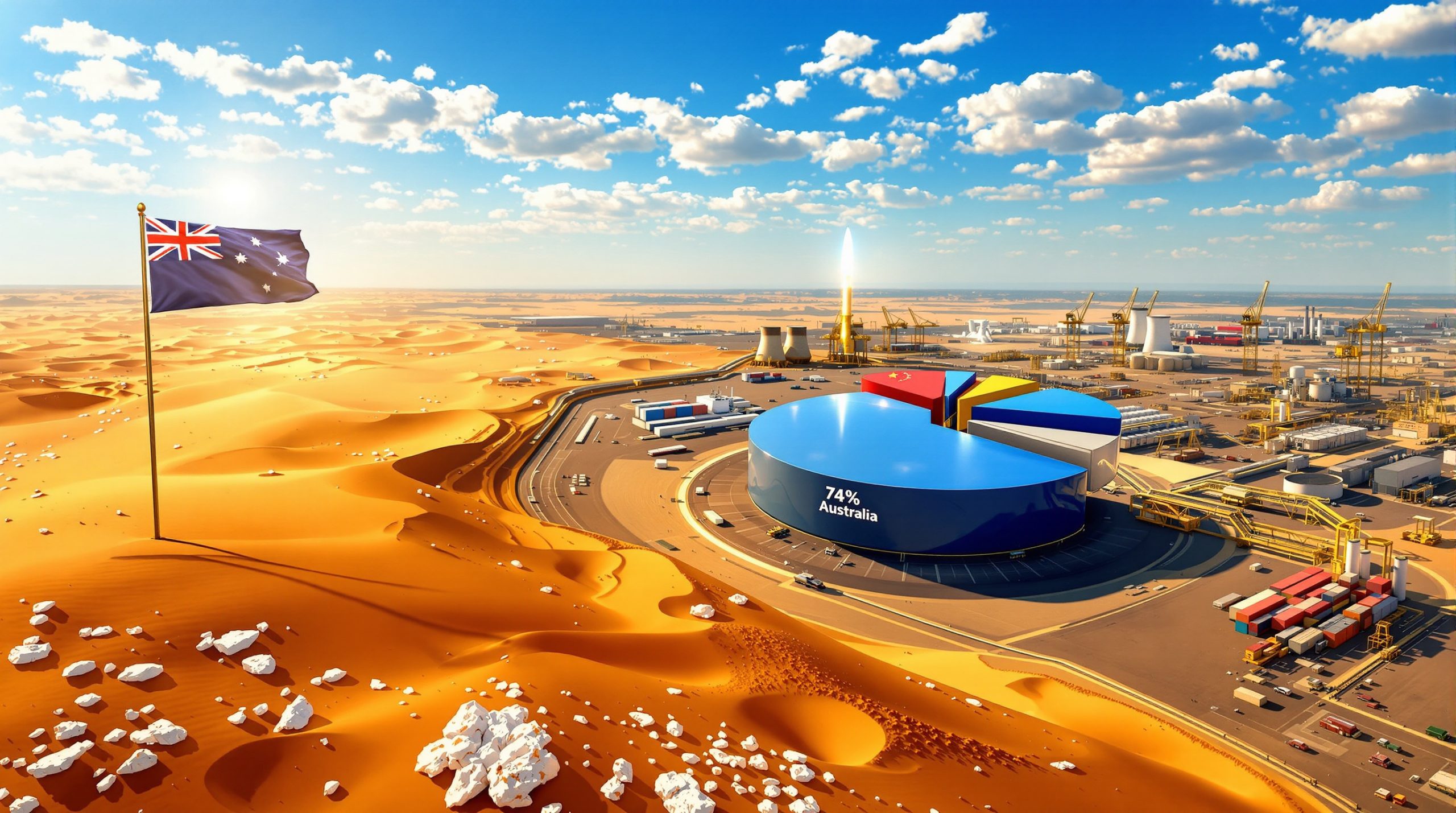The Growing Pressure on High-Cost Lithium Producers: Market Analysis and Future Outlook
In the rapidly evolving lithium market, a significant divide is emerging between producers based on their cost structures. With approximately 40% of global lithium supply capacity currently operating at or below breakeven point, the industry faces unprecedented challenges that are reshaping its competitive landscape and future trajectory. Understanding the current lithium market dynamics has become essential for investors and industry participants alike.
What is Causing the Current Pressure on Lithium Producers?
The Market Oversupply Situation
The global lithium market is experiencing substantial oversupply conditions, creating existential challenges for many producers. According to data from Albemarle Corporation, approximately 40% of global lithium supply capacity is currently operating at or below the breakeven point, with one-third of these financially stressed operations having already suspended production.
This oversupply stems primarily from the rapid capacity expansion that occurred during the 2021-2023 boom period, when producers rushed to capitalize on record-high prices. As BloombergNEF analysis indicates, this expansion outpaced electric vehicle demand growth by approximately 20% in 2024, creating a significant supply glut.
The consequences have been severe, particularly for operations with higher cost structures. Mines that expanded during the market peak now face difficult decisions about whether to continue operating at losses or suspend production until market conditions improve. These challenges highlight why investing in mining stocks requires careful analysis of production costs and market positioning.
Price Volatility and Its Impact
Lithium has experienced one of the most dramatic price collapses in commodity markets, falling from peak levels of approximately $70,000 per tonne in late 2022 to around $15,000 per tonne by May 2025. This 78% decline has eliminated profit margins for all but the most efficient producers.
Regional price variations further complicate the picture. While Asian spot markets show the most severe declines, contract prices in Europe and North America have demonstrated more stability, offering some protection to producers selling into these markets.
"Higher-cost producers face existential pressure as prices remain below incentive levels for new projects," noted Albemarle executives during a recent earnings call, highlighting the severity of current market conditions.
The prolonged downward price trend has created an unsustainable operating environment for marginal producers, forcing difficult decisions around production cutbacks, asset sales, and in some cases, complete operational suspension. According to recent market analysis by Market Index, only a single Australian lithium mine is currently profitable at current price levels.
How Are Different Types of Lithium Operations Affected?
Hard Rock Mining Operations (Spodumene)
Australian spodumene producers have been particularly hard hit by the market downturn. Their production costs typically range between $8,000 and $12,000 per tonne, significantly higher than their brine-based competitors.
These operations face multiple disadvantages:
- Higher energy costs: Spodumene conversion to battery-grade lithium hydroxide consumes between 9-12 kWh per kilogram, approximately double the energy requirements of brine evaporation methods
- Conversion complexity: Hard rock miners often ship concentrate to Chinese converters, adding $200-$300 per tonne in logistics costs
- Multi-stage processing: The requirement for energy-intensive crushing, concentration, and conversion reduces margin capture potential
Pilbara Minerals' CEO emphasized this challenge, stating: "Capital discipline is critical as margins evaporate in the current price environment." The company has already implemented significant cost-reduction measures to weather the downturn.
Notable examples of hard rock operations facing pressure include the Greenbushes Mine in Australia, which suspended approximately 30% of its output in Q1 2025 due to margin compression, and Wodgina Mine, which curtailed production by 50% in 2024.
Brine Operations
South American brine producers demonstrate considerably greater resilience in the current market, primarily due to their advantageous cost position. Their production costs typically range between $4,000 and $6,000 per tonne, providing a substantial buffer against price declines.
Key advantages of brine operations include:
- Lower energy requirements: Solar evaporation as the primary concentration method significantly reduces energy costs
- Simpler processing: Fewer chemical inputs and processing steps to reach battery-grade material
- Established infrastructure: Most major brine operations have long-standing operations with depreciated capital costs
SQM (Chile) has maintained profitability throughout the downturn with brine operations achieving cash costs around $4,500 per tonne, positioning the company to weather extended periods of low prices. This advantage is one reason behind Chile's lithium expansion efforts in the global market.
However, brine operations face their own challenges, including:
- Longer development timelines: New brine projects typically require 5-7 years from discovery to production
- Water usage concerns: Traditional brine operations consume approximately 500,000 liters of water per tonne of lithium produced
- Environmental scrutiny: Increasing regulatory pressure regarding water usage in arid regions like the Atacama Desert
DLE (Direct Lithium Extraction) Projects
Emerging DLE technologies represent a potential disruptor to the established lithium production paradigm, but face significant hurdles in the current market environment.
DLE offers several theoretical advantages:
- Reduced environmental footprint: DLE technology can reduce water usage by up to 80% compared to traditional brine methods
- Faster production timelines: Potential to extract lithium in days rather than months
- Ability to process lower-grade resources: Making previously uneconomic resources viable
Despite these advantages, commercial viability remains challenging due to:
- Higher capital intensity: First-generation DLE projects require 30-40% more upfront investment
- Technology risk: Limited commercial-scale operations with proven economics
- Energy requirements: Many DLE processes require significant electricity inputs
Albemarle has allocated $500 million to DLE R&D in 2025, betting that technological advancements will eventually reshape the industry cost curve. However, in the current market environment, only the most advanced DLE projects with strategic backing are moving forward.
Which Regions Face the Greatest Challenges?
Australia's Lithium Sector Under Pressure
Australia's lithium ambitions face particularly acute challenges, with 6 of 15 major lithium mines having reduced output in 2024. The country's average lithium cash costs have risen to approximately $11,000 per tonne in 2025, up from $8,500 per tonne in 2022, further squeezing margins.
This contraction has had measurable economic impacts:
- Western Australia's mining employment has dropped 12% year-over-year
- The Western Australia Premier reported that "State GDP growth slowed to 1.2% in 2024 due to lithium sector contraction"
- Several mines have changed ownership at distressed valuations, including Mt. Marion Mine, which was sold to a Chinese consortium at a 40% valuation discount
The Australian government has responded with targeted support measures, including royalty relief programs and expedited permitting for value-added processing facilities to capture more of the value chain domestically.
North American Production Economics
North American lithium operations face a complex landscape where strategic importance often conflicts with economic realities. Production costs in the region typically exceed global averages by 15-25% due to:
- Higher labor costs
- More stringent environmental regulations
- Less developed lithium processing infrastructure
- Longer distances to battery manufacturing centers
However, the Inflation Reduction Act (IRA) has created significant countervailing incentives through:
- Direct production tax credits for domestically-produced lithium
- Grants for processing facility construction
- Loan guarantees for qualifying critical mineral projects
- EV tax credits that encourage North American mineral sourcing
These incentives have attracted Australian lithium hydroxide exporters and spurred domestic project development, despite challenging global market conditions. Rio Tinto's lithium expansion at its Rincon project represents a major commitment to the future of lithium production, despite current market pressures.
Emerging African Producers
New lithium projects in Africa face a particularly difficult launch environment. Despite often favorable geology, these projects must overcome:
- Financing hurdles: Equity markets have become increasingly selective, with lithium equity raises down 70% year-over-year
- Infrastructure limitations: Many projects require significant investment in power, water, and transportation infrastructure
- Political risk perceptions: Investor concerns about regulatory stability and resource nationalism
- Limited processing expertise: Few established lithium processing capabilities require exporting raw material
Projects like Mali's Goulamina mine have faced financing challenges despite world-class resource characteristics. African producers that can demonstrate first-quartile cost potential and secure strategic partnerships with established industry players maintain the best prospects for advancing in the current environment.
What Are the Financial Implications for Lithium Companies?
Profit Margin Compression
The lithium sector has experienced dramatic margin compression, with industry EBITDA margins falling from an average of 45% in 2022 to approximately 8% in 2025. This compression has not affected all producers equally:
- First-quartile cost producers maintain 15-20% EBITDA margins
- Second-quartile producers hover near break-even
- Third and fourth-quartile producers operate at negative cash margins
This margin stratification has created a multi-speed market where low-cost producers continue generating cash while higher-cost peers consume capital reserves or suspend operations entirely.
The historical premium valuations assigned to lithium producers have largely evaporated, with sector price-to-earnings ratios contracting from 25-30x during the boom to 8-12x currently, more in line with traditional mining valuations.
Balance Sheet Challenges
High-cost producers face mounting financial pressures, with approximately $2.5 billion in debt maturities coming due through 2026. S&P Global has warned that "leveraged producers risk covenant breaches if prices stay below $18,000 per tonne" for an extended period.
The debt profiles of lithium companies reveal stark differences:
- Debt-to-EBITDA ratios exceed 5x for many mid-tier producers
- Major producers maintain more conservative 2x leverage ratios
- Smaller players increasingly face refinancing challenges
Some companies have taken preemptive action to shore up their balance sheets. Livent Corporation secured $1.2 billion in convertible notes to avoid a potential liquidity crunch, while others have pursued asset sales or joint ventures to generate cash.
Companies unable to secure additional financing face increasingly limited options, as evidenced by Sigma Lithium's delisting from NASDAQ after failing to meet equity requirements.
Investment Implications
Investor sentiment toward the lithium sector has undergone a fundamental shift, with capital becoming increasingly selective. The investment landscape now features:
- Significant differentiation between low-cost and high-cost producers
- Premium valuations for companies with vertical integration capabilities
- Increased focus on project economics rather than resource size
- Growing importance of strategic partnerships with battery manufacturers and OEMs
For long-term investors, the current environment presents both risks and opportunities. While near-term price recovery appears unlikely before 2026, current valuations may present entry points for projects with first-quartile cost positions and strong financial backing.
How Are Major Producers Responding to Market Pressures?
Cost Reduction Strategies
Major producers have implemented aggressive cost-cutting measures to maintain viability during the downturn:
- Operational efficiency: Implementing advanced process control systems to improve recovery rates
- Energy optimization: Investing in renewable energy sources to reduce operating costs
- Workforce rationalization: Reducing staffing levels and implementing contractor restrictions
- Supply chain integration: Securing lower costs through long-term contracts and vertical integration
These efforts have yielded measurable results, with several major producers reporting 10-15% reductions in unit costs over the past 12 months. However, the scope for further cost reduction appears limited without more fundamental operational changes.
Production Curtailment Decisions
Strategic production cuts have become increasingly common as producers attempt to support market balance:
- Temporary mine suspensions: Placing higher-cost operations on care and maintenance
- Reduced operating rates: Running facilities at 50-70% of nameplate capacity
- Delayed expansion projects: Postponing approved capacity additions until market conditions improve
- Canceled greenfield developments: Shelving early-stage projects indefinitely
These curtailment decisions face coordination challenges in a fragmented producer landscape, with no single company controlling sufficient market share to unilaterally influence prices. The absence of formal production discipline mechanisms, unlike in markets such as oil (OPEC) or potash, complicates coordinated supply responses.
Strategic Repositioning
Forward-thinking producers are using the downturn to fundamentally reposition their businesses:
- 60% of major producers now hold stakes in downstream battery plants, seeking to capture additional margin and secure offtake channels
- Vertical integration strategies have accelerated, with Albemarle and Thyssenkrupp forming a joint venture to build Europe's largest lithium refinery in Germany
- Product diversification has increased, with companies developing specialized lithium compounds for premium applications
- Strategic partnerships with OEMs have provided capital and offtake security, as demonstrated by Liontown Resources' agreement with LG Chem
These strategic shifts represent a fundamental evolution in the lithium business model, moving from pure commodity production toward more integrated and specialized positions within the battery materials value chain.
What Does the Future Hold for Lithium Markets?
Supply Rationalization Timeline
Market analysts project continued pressure on high-cost lithium producers through at least mid-2026, with several factors influencing the supply rationalization timeline:
- Most curtailed production remains on care and maintenance rather than permanently closed, creating potential for rapid supply responses to price improvements
- Approximately 65% of suspended production could return within 6-12 months of sustained price recovery
- Project delays and cancellations will restrict new supply additions from 2026-2028, potentially creating the conditions for the next supply shortage
- Chinese conversion capacity growth has slowed significantly, removing a key driver of previous oversupply
The resolution of current market imbalances likely requires both continued production discipline and demand acceleration, with neither factor alone sufficient to restore market balance in the near term.
Demand Growth Projections
Despite near-term challenges, long-term demand fundamentals remain strong:
- BloombergNEF forecasts lithium demand reaching 2.5 million tonnes LCE by 2030, representing a compound annual growth rate of approximately 20%
- Electric vehicle penetration rates continue increasing globally, with major markets approaching inflection points in adoption
- Energy storage system deployments are accelerating even faster than EV growth, adding significant demand from a previously minor segment
- Battery chemistry evolution toward higher-nickel cathodes partially offsets efficiency gains, maintaining strong lithium intensity per vehicle
Regional demand growth varies significantly, with China's EV market showing signs of maturation while European and North American markets continue accelerating. The emergence of India and Southeast Asia as significant EV markets represents an important new demand vector beyond 2027.
Price Recovery Scenarios
Potential price recovery patterns depend on several key factors:
- Most analysts consider $20,000 per tonne as the minimum sustainable price needed to incentivize new production capacity
- Price recovery will likely begin with spot market stabilization, followed by gradual improvement in contract prices
- Regional price differentials may persist, with North American prices commanding premiums due to IRA incentives
- Future price cycles may feature lower peaks and higher floors as the market matures
The most likely catalyst for market rebalancing appears to be accelerating demand rather than supply discipline, given the fragmented nature of the producer landscape and the temporary nature of most production curtailments.
Want to Identify the Next Major Lithium Discovery?
Discover significant ASX mineral announcements before the market with real-time alerts powered by Discovery Alert's proprietary Discovery IQ model, turning complex lithium market data into actionable opportunities. Visit our dedicated discoveries page to understand how major mineral discoveries can generate substantial returns and begin your 30-day free trial today.




